Wedding Jewelry Buyer's Guide
Wedding Jewelry Buyer's Guide
Getting Started
Choosing an engagement ring and wedding band from today’s thousands of styles can be a challenging decision! It’s nice to understand the basics. It helps to divide the decision into 2 parts: the center diamond (or gemstone), and the setting.
Let’s talk about the center diamond here.

Getting Started
Choosing an engagement ring and wedding band from today’s thousands of styles can be a challenging decision! It’s nice to understand the basics. It helps to divide the decision into 2 parts: the center diamond (or gemstone), and the setting.
Let’s talk about the center diamond here.

The Center Diamond
Most engagement rings have a diamond as the center stone, but some people choose alternatives such as sapphire, emerald, and ruby. For now, we’ll discuss center diamonds. If you want to learn more about other gems, they will be covered soon in another article.
Choosing Your Center Diamond Shape
The SHAPE – Diamonds come in many shapes. We can provide any diamond shape that you want. Every shape has it’s own unique “look”. The most popular shape is Round, usually known as the “Round Brilliant”. About 1/2 of the center diamonds sold today are Round Brilliants. One reason for its popularity is the fact that it is very versatile, and works with many styles of rings. Since re-mounting is always an option later, that’s one important consideration. Also, a well cut Round Brilliant shape may appear to have more brilliance than other shapes, due to the more symmetrical placement of the facets.
The remaining 1/2 is split between all the other shapes, and all the percentages vary over time. But the popularity of a cut is not the most important factor in your decision. They are all very beautiful, and each shape can make a fabulous engagement ring. What matters most is the shape you like best. Your ring expresses your uniqueness and your own taste.
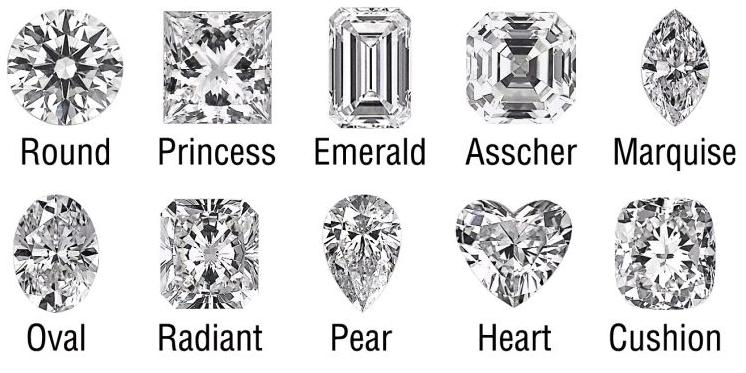
The 4 C's of Diamond GradingCut, Carats, Color & Clarity
The GRADE – Diamonds are graded with 4 characteristics in mind – Cut, Carats, Color and Clarity – known as the 4 C’s.
No genuine diamond formed in the earth is perfect, but some are much better than others. Choosing a grade, therefore, comes down to a decision of “what is good enough?” Since the cost is a big factor, you have to look at all the qualities of the diamond you’re considering to make that decision.
You want to choose a beautiful diamond, within the price range you have in mind. If you have good cut, color and clarity, you will have a very beautiful diamond. If you have very good cut, color and clarity, it will be even better, but the difference is fairly small. And if you have excellent cut, color and clarity, the difference will be even smaller. But the price goes up considerably at each level. So you just have to decide on the trade-offs between the grade, the cost, and the size (carats) that you can purchase.
To be more specific, what most people consider to be a good color grade is “near colorless”. What most people consider a good cut grade is (you guessed it) a “good” cut. And what most people consider a good clarity grade is one that is “eye clean”, meaning you can’t see any imperfections without magnifying the diamond. We’ll explain more in each section below. If you understand the grading process, you can use the information to get the best looking diamond for your money.

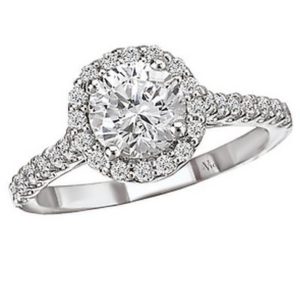
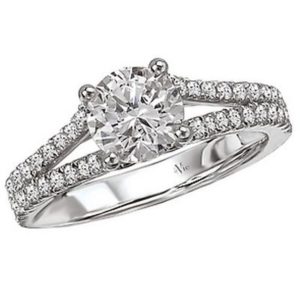
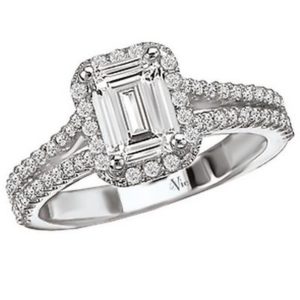
At Sabyl’s, we will help you choose just the right stone,
in each of the 4 C’s, to suit your taste and budget.
Carats
A CARAT is a unit of weight, not size. One carat is 2/10ths of a gram.
But the measurements of diamonds are closely related to the carat weight. The image below shows the average sizes of round and princess cut diamonds next to a lady’s hand.
One 100th of a carat is called a “point”. 100 points = 1 carat. So 50 points = 1/2 carat, 75 points = 3/4th of a carat, and so forth. Diamonds are not always the weights shows in the chart. A diamond may be 49 points, 51 points, etc. The exact weight is important because the weight is a major factor in the price. Engagement ring center diamonds are usually somewhere between about 20 points and 2 carats.
Because larger diamonds are more rare, a 1 carat diamond costs much more than 2 times as much as a 1/2 carat diamond. Instead it costs about 3 or 4 times as much. The price per carat increases with the weight.
The weight of the center diamond is usually the biggest factor in the cost of an engagement ring. For example, if a 1 carat diamond costs more than your budget limit, a 3/4 carat diamond might be just right.
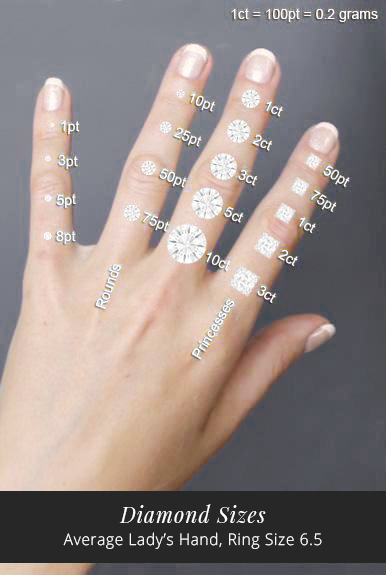
Cut
The CUT is a measure of is the skill of diamond cutter in creating the finished diamond. It includes the proportions, the angles, the symmetry and the polish (smoothness of the surface). Cut grading can get very technical, but cut grades are usually described as “Excellent” (or “Ideal), “Very Good”, “Good”, “Fair” and “Poor”. Most people agree that a “Good” cut is very beautiful, and “Very Good” and “Excellent” are each a little more brilliant. Since the higher cut grades may cost more, we suggest looking for at least a “Good” cut grade, and then balancing the cut against the other factors before making a final decision.
Grading the cut of a diamond is a very complex process, involving many measurements, and calculations. The illustration below shows some of the measurements that are taken into consideration. For those who don’t care to get extremely technical, we’ll just say that a “good” cut has a lot of brilliance. The GIA Lab concluded after 10 years of studying diamond cut grading, “if it looks like a good cut, it probably is”.
We can help you choose the right stone for you. Just call or come in to meet with us and we’ll help you find out what you really want.
The Brilliant cut diamonds – which includes the round, princess, radiant, oval, pear, marquise, heart – are designed to refract as much light as possible from the top surface back out the top. The next illustration shows how the light “bounces” around inside the stone. In a well cut stone, a lot of light.

Diamond Image Showing Measurements that Affect the Cut Grade
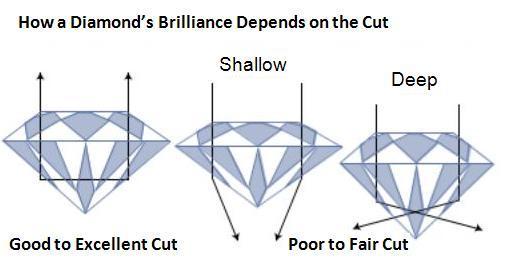
Diamond Image Showing How the Depth Affects the Brilliance
Color
The Color grade is a measure of the amount of color that is visible. Diamond color is graded on a scale of “D” to “Z”, with D being the best color and Z the worst. There are many letters between D and Z, and the difference between 2 letters is very small. Since there is a very small difference between 2 letters, they are grouped into “colorless” (D, E and F), “near colorless” (G, H, I and J), “lightly tinted” (K, L, and M), and so forth. The price is lower than the colorless and near colorless grades. Some buyers will accept a slightly tinted color in order to have a larger diamond.
When you make an appointment to talk with us, we will show you exactly what each color grade looks like, to make your decision very easy.
Clarity
The CLARITY of a diamond is a way of describing the natural imperfections in every genuine diamond that is formed in the earth, under imperfect conditions. There is no such thing as a “perfect” diamond. The difference is in how perfect or imperfect it is. If a diamond looks “perfect to the unaided eye, it is usually considered clear enough for an engagement ring.
We call these imperfections “inclusions”. These inclusions, such as trace minerals, scratches or fractures, can appear either on the surface or within the diamond. The number, size, location and nature of these inclusions determine the clarity of the diamond. The clearer diamonds are more rare, and more sought after, and thus more expensive. It’s ok to choose a diamond that’s “eye clean”, meaning that there are no imperfections that can be seen without magnification. After all, if you can’t see the inclusions, they won’t look any better if they’re even smaller. However, in some cases, the inclusions may affect the way light is refracted back thought the face of the diamond, reducing it’s brilliance and fire. In those cases, you may opt for a higher clarity or a different diamond of the same clarity grade.
Illustration of Diamond Clarity Grades
When you understand the 4 C’s, you can choose a diamond with confidence. We will help you make a decision you’ll be pleased with, on this very special occasion!
Note from Sabyl: Yay! We made it through. That wasn’t so bad, was it? Now, let’s meet and we’ll show you some real diamonds.
That’s the fun part! We’ll help make this one of your favorite memories.
Custom jewelry design consultations are by appointment only. Our design studio is conveniently located in the Merovan Office Center, directly across Woodruff Road from Chili’s Restaurant and Sam’s Club.
Please contact us for any questions or special requests at 864-593-5396
or select a time and date for a consultation using the form below.
Google ReviewsAs a family owned business we are committed to quality and personalized service.
Here is what some of our happy clients have to say.
[egpr_reviews id=”4949″]


